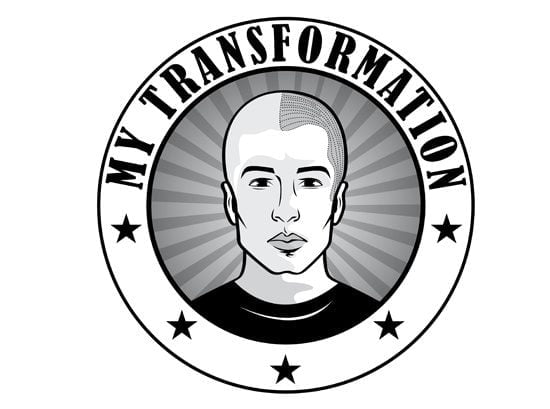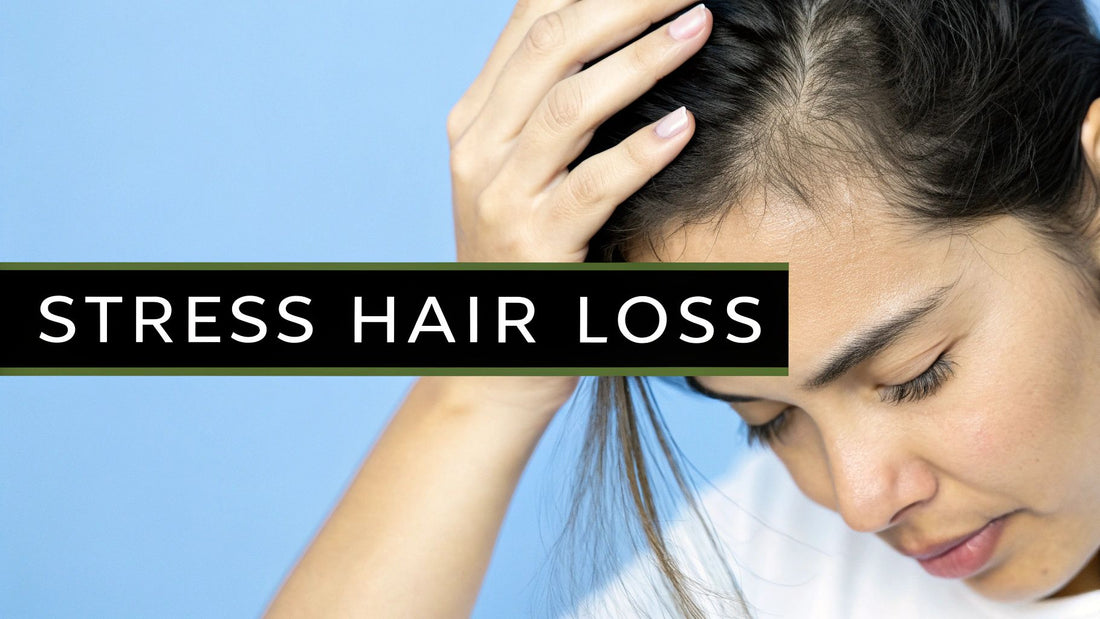
Stress-Related Hair Loss: Causes & Solutions
Share
If you've ever found more hair in your brush than usual and wondered, "Can stress really make my hair fall out?", the answer is a resounding yes. Experiencing significant emotional or physical stress is a scientifically proven trigger for hair shedding. In fact, it's one of the most common—yet often misunderstood—reasons for temporary hair loss.
The Hidden Connection Between Stress and Your Hair
Imagine your body's energy supply is like the power grid for a house. On a normal day, electricity flows to every room, keeping the lights on, the fridge cold, and the TV running. Your hair follicles, which are constantly working hard to produce new strands, are just one of the many appliances drawing from this power source.
Now, picture what happens during a massive power surge caused by a big life event—a high-pressure job, a personal crisis, or even a sudden illness. Your body’s internal 'safety switch' flips to protect its most critical systems. It immediately cuts power to non-essential functions to focus all its resources on managing the immediate threat.
Unfortunately for your hair, growth is considered a non-essential task in this state of emergency. The energy that was fuelling your hair follicles gets diverted elsewhere, forcing them to shut down production ahead of schedule. This is the heart of stress related hair loss; it's your body's survival mechanism in action, but one with consequences that can be pretty distressing to see in the mirror.
The Role of Cortisol
This whole response is orchestrated by hormones, with cortisol taking centre stage. Often called the "stress hormone," cortisol floods your system when you're feeling anxious or under pressure. In Australia, this type of hair loss is most commonly linked to a condition called telogen effluvium, where high cortisol levels throw the normal hair growth cycle into disarray. Chronic stressors, like poor sleep or ongoing work pressure, keep cortisol levels persistently high, pushing more and more hair follicles into the shedding phase long before they’re ready. To delve deeper, you can find more information on how stress impacts the hair growth cycle from Australian health experts.
This biological process can create a frustrating cycle: a stressful event happens, and a few months later, you start noticing hair loss. Seeing your hair shed then becomes a new source of stress, which can unfortunately prolong the problem.
What This Guide Will Cover
Getting a handle on this connection is the first step toward taking back control. It's not just "all in your head"; there's a clear physiological reason for what's happening. We’ve designed this guide to walk you through everything you need to know about stress-induced hair loss.
Here's what we'll explore:
- The science behind how stress hormones directly interfere with your hair's growth cycle.
- The different types of hair loss that stress can trigger and their unique signs.
- Practical, real-world strategies for managing stress and encouraging healthy hair regrowth.
By the time you're done, you'll have a clear roadmap for moving forward, armed with the knowledge to tackle the root cause and support your body's natural recovery.
How Stress Disrupts Your Hair Growth Cycle
To really get your head around how stress and hair loss are linked, it helps to imagine your body as a finely tuned machine. Under normal circumstances, it smartly distributes energy and nutrients to all its systems, including the one responsible for growing your hair.
But when a major stressor hits—whether it's a traumatic event, intense work pressure, or a serious illness—your body switches into survival mode. Your brain sounds the alarm, and resources are immediately diverted away from non-essential tasks, like hair production, and channelled towards critical functions needed to handle the crisis.
The main culprit behind this shift is cortisol, our primary stress hormone. A prolonged surge of cortisol floods your system, sending a powerful signal directly to your hair follicles. This signal effectively disrupts their natural growth rhythm, leading to the excessive shedding we know as stress-related hair loss.
This is the core of the problem: your body is so focused on survival that it puts hair growth on the back burner.

The image above maps it out clearly. The stress you feel mentally is translated into a physical response, with cortisol acting as the messenger that tells your hair follicles to shut down.
The Anagen to Telogen Shift
Healthy hair follows a predictable cycle with three key phases. This organised process is what keeps your hair looking full, ensuring old hairs are shed only when new ones are ready to grow.
-
Anagen (Growth Phase): This is the active stage where follicles are busy building hair strands. It can last anywhere from two to seven years, and at any one time, about 85-90% of the hairs on your head are in this phase.
-
Catagen (Transition Phase): A very short transitional period, usually about two weeks, where hair growth grinds to a halt. The follicle shrinks and prepares to enter its resting stage.
-
Telogen (Resting & Shedding Phase): The final stage, which lasts for about three months. The hair just sits in the follicle, no longer growing, before it eventually sheds to make way for a new hair.
The major issue with stress is that it throws this whole cycle out of whack.
A sudden, significant shock to your system can push a large number of hairs prematurely from the anagen (growth) phase straight into the telogen (shedding) phase.
This abrupt shift is what triggers a condition called telogen effluvium, the most common type of stress-induced hair loss. Instead of losing the normal 50-100 hairs a day, you might find yourself losing 300 or more. And because the telogen phase lasts for about three months, there's often a noticeable delay between the stressful event and when you actually start seeing all that extra hair in the shower drain. For a closer look at these stages, our guide on the hair growth cycle is a great resource.
From Stressor to Shedding
The good news? This process doesn't permanently damage the hair follicle. Think of it like a factory that's been temporarily shut down during a power outage—the machinery is perfectly fine, just waiting for the power to come back on.
Once the stressor is gone and your body finds its balance again, the follicles can re-enter the anagen phase and resume normal hair production. This is why stress-related hair loss is almost always temporary. Recovery just takes a bit of time and patience.
Identifying the Types of Stress-Related Hair Loss
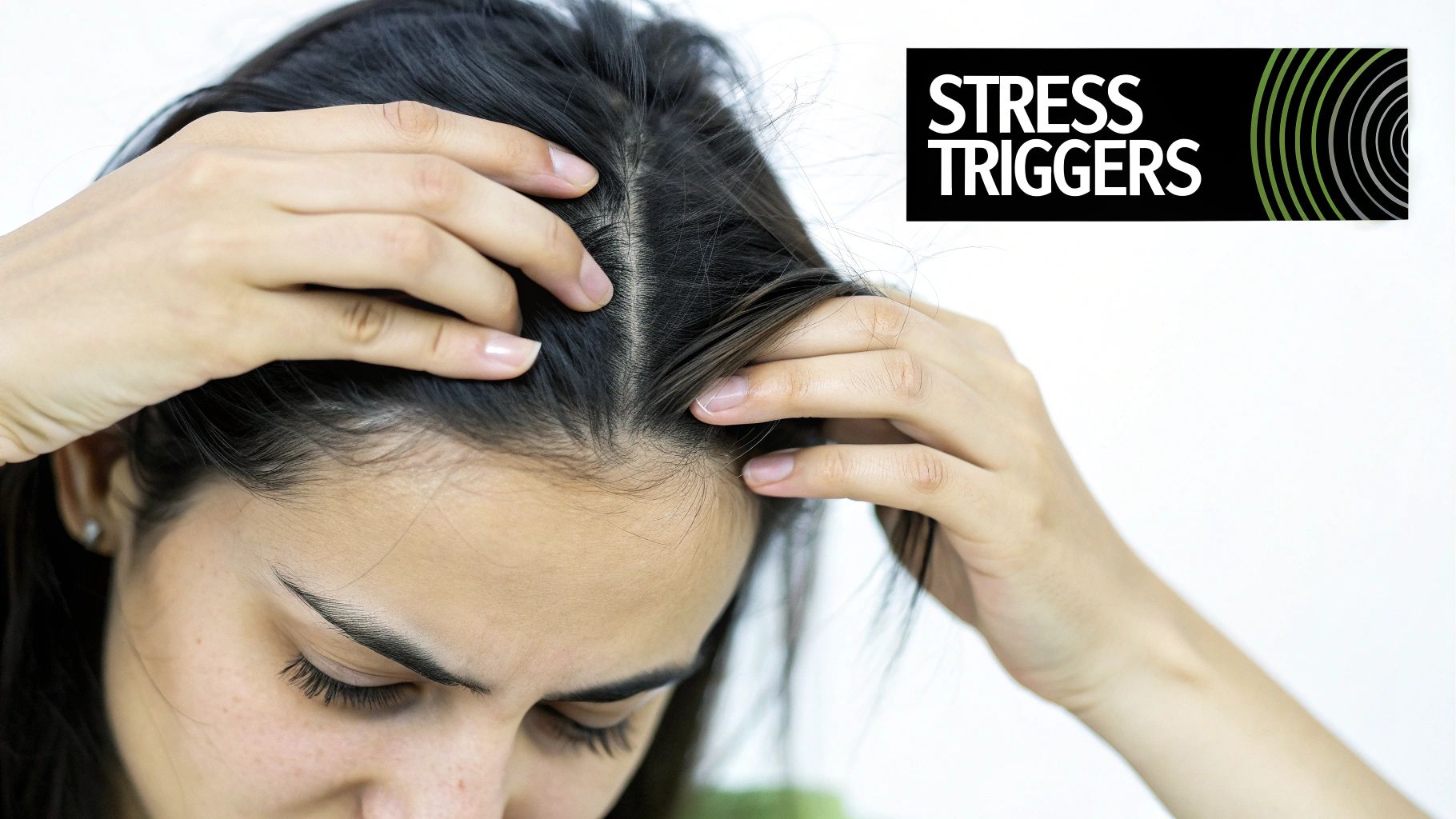
When you hear "stress-related hair loss," you probably picture a general, all-over thinning. But in reality, stress can pull the trigger on several distinct hair loss conditions, each with its own signature pattern and cause. Figuring out which one you might be dealing with is the critical first step toward getting the right help.
Not all stress-induced shedding is created equal. By getting to know the main types, you can have a much more informed chat with your doctor or hair loss specialist. It gives you a clearer picture of what's happening on your own scalp.
Let's break down the three main culprits linked to stress.
Telogen Effluvium: The Most Common Suspect
By a long shot, Telogen Effluvium (TE) is the most frequent form of stress-related hair loss. This is the condition we’ve been talking about, where a major shock to your system prematurely pushes a huge chunk of your hair follicles into the shedding (telogen) phase. The result isn't a bald patch, but rather a noticeable, diffuse thinning across your entire scalp.
One of the defining, and often confusing, signs of TE is the delay. The shedding doesn't start right after the stressful event. Instead, it typically shows up a full two to three months later. This time lag often makes it incredibly difficult to connect the hair loss you're seeing today with the stressor that happened weeks ago, which can lead to even more worry.
Think of it like this: your scalp is a garden where every plant has its own cycle of growing and resting. A sudden, unexpected frost (the stress) forces a massive number of them to go dormant all at once. You don't see the sparse garden immediately, but a few months later, the widespread effect becomes obvious. The good news? The roots are still healthy, just waiting for better conditions to grow again.
Trichotillomania: A Compulsive Reaction to Stress
Where Telogen Effluvium is a physical reaction, Trichotillomania is a behavioural one. It's a complex disorder driven by a recurrent, irresistible urge to pull out hair from the scalp, eyebrows, or anywhere else on the body. This isn't just a bad habit; for many, it’s an unconscious coping mechanism for dealing with intense stress, anxiety, or emotional pain.
The hair loss from Trichotillomania looks quite different. It typically appears in patchy, irregular patterns that mirror where the person pulls. You might also notice hairs that are broken off at different lengths. For anyone experiencing this, the path to hair regrowth starts with managing the underlying stress that triggers the pulling.
Alopecia Areata: An Autoimmune Response Sparked by Stress
Alopecia Areata is an autoimmune disease. This is where the body’s immune system gets confused and mistakenly attacks its own healthy hair follicles. This assault causes the follicles to shrink and dramatically slow down hair production, leading to very distinct, smooth, round bald patches that can look like coins on the scalp or body.
While the fundamental cause is autoimmune, severe emotional or physical stress is a well-known trigger for flare-ups. In fact, research has pointed to a connection between conditions like post-traumatic stress disorder (PTSD) and the onset of Alopecia Areata. It’s a powerful reminder of just how much stress can impact our immune function.
To put it all together, here’s a quick guide to tell them apart:
| Condition | Primary Cause | Pattern of Hair Loss | Onset After Stress |
|---|---|---|---|
| Telogen Effluvium | Physiological shock | Diffuse, all-over thinning | 2-3 months |
| Trichotillomania | Compulsive behaviour | Irregular, patchy areas | Immediate (during stress) |
| Alopecia Areata | Autoimmune response | Smooth, round bald spots | Variable |
Seeing which of these patterns fits your experience is invaluable. It equips you with the right language to seek a professional diagnosis, which is the only way to rule out other causes and get started on the most effective path to recovery.
How Stress Worsens Hair Loss in Men
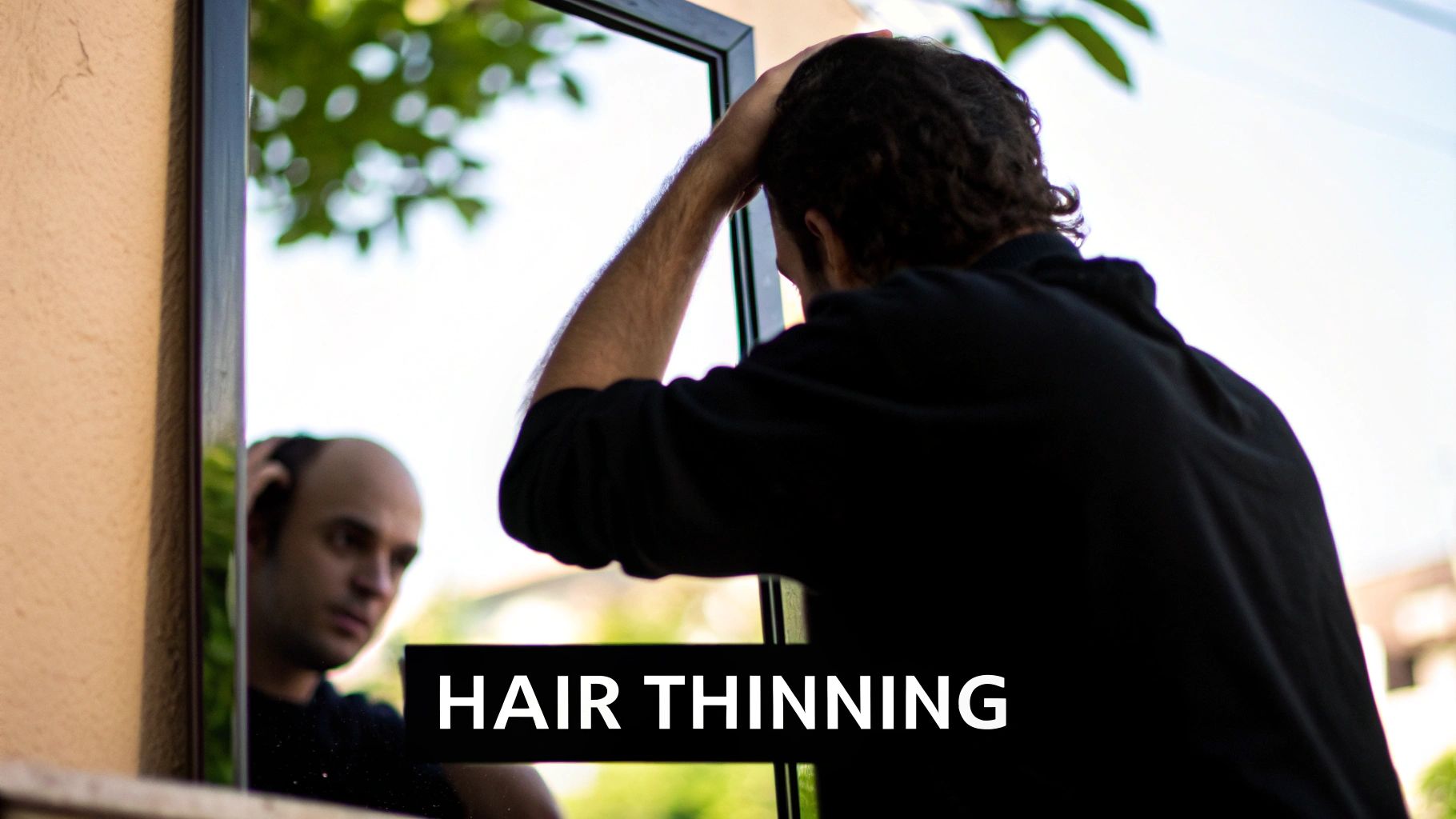
Many blokes chalk up hair loss to a simple roll of the genetic dice—something locked in by their family tree. And while it’s true that male pattern baldness (androgenetic alopecia) has a strong hereditary link, thinking it’s a foregone conclusion ignores a huge factor that can throw petrol on the fire: chronic stress.
Think of it like this: your genetics lay out the blueprint for your hair's future. Stress, on the other hand, is like a rogue construction crew on a caffeine buzz, working around the clock to speed up the job. It doesn't write the plans, but it can certainly fast-track the timeline, making thinning show up earlier and progress much faster than it otherwise might have.
The real issue is how stress hormones team up with hair follicles that are already sensitive to dihydrotestosterone (DHT), the main hormone behind male pattern baldness.
The Stress and DHT Connection
If you're genetically predisposed to hair loss, certain follicles on your scalp have a built-in sensitivity to DHT. This hormone latches onto them, causing them to shrink over time until they eventually give up producing hair altogether. That's the core mechanism of male pattern baldness. We dive deeper into this in our guide on why men suffer from male pattern hair loss.
Now, let's bring chronic stress into the picture. When you're constantly stressed, your cortisol levels stay high, which creates a low-grade inflammation throughout your body, scalp included. This inflammatory state makes those sensitive follicles even more susceptible to the damaging effects of DHT.
You can think of stress as an amplifier. It takes that pre-existing genetic sensitivity to DHT and cranks up the volume, intensifying the follicle-shrinking process and putting your hair loss into overdrive.
This creates a perfect storm, especially for men in high-pressure jobs or life situations. In Australia, the daily grind—demanding careers, long commutes, and financial worries—all contribute to constantly elevated stress levels. These aren't just emotionally draining; they have a very real, physical impact on your hair.
It's no surprise then that male-pattern baldness, which stress can make worse, affects about 50% of Australian men by the age of 50 and a staggering 80% by age 70.
Getting your head around this connection is empowering. It reframes the situation from "it's just in my genes" to something you can actually manage. You can't change your DNA, but you absolutely have a say in how your body responds to stress. By bringing effective stress-reduction techniques into your routine, you can ease off that accelerator, giving your hair a better fighting chance and making stress management a non-negotiable part of any man's hair care strategy.
The Unique Impact of Stress on Women's Hair Loss
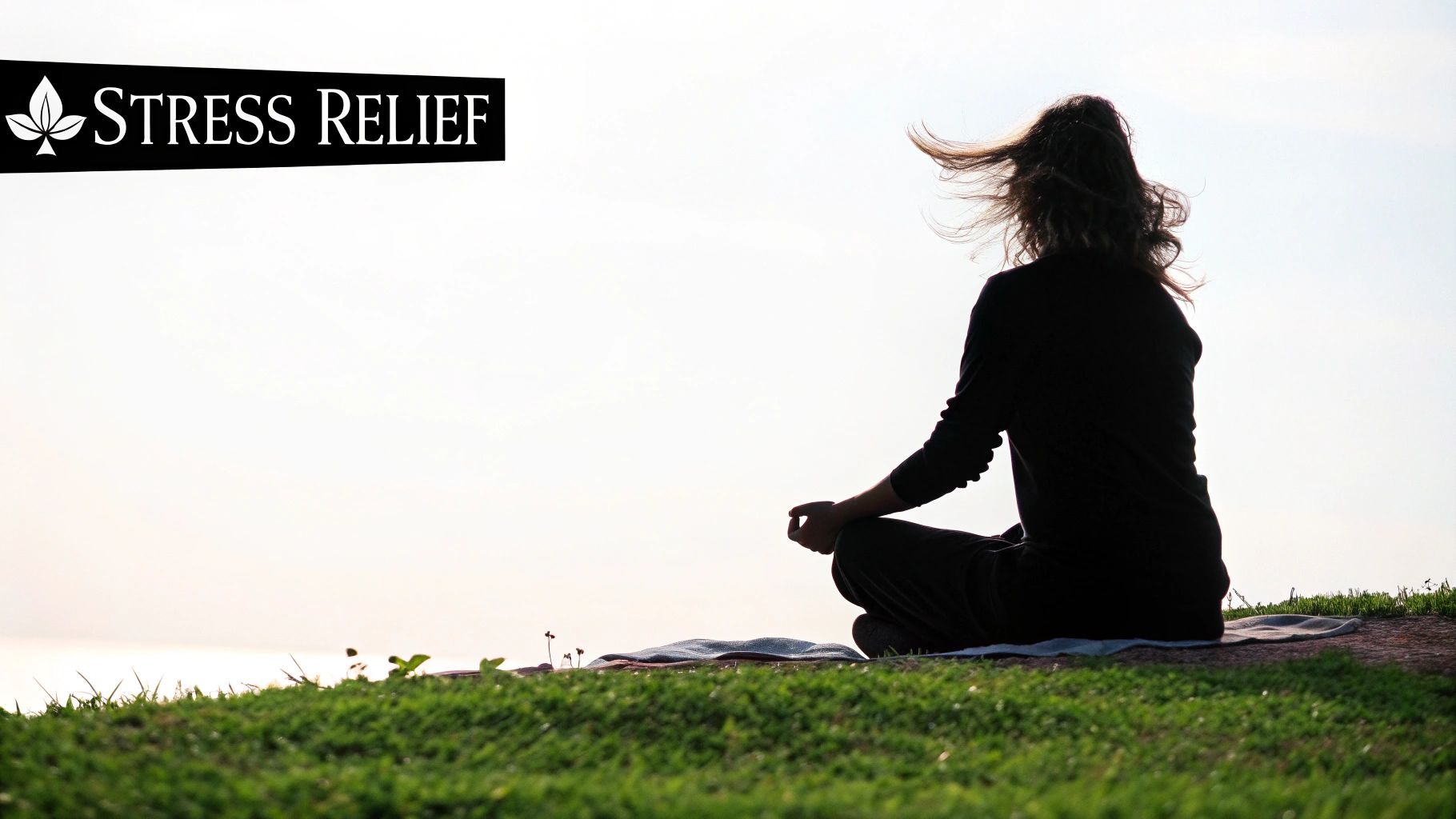
For so many women, our hair is tangled up in our sense of identity and how we present ourselves to the world. That's why hair loss can be such an incredibly emotional and distressing experience—it goes far deeper than a simple cosmetic issue. When stress is the culprit, it creates a tough situation where biological triggers get mixed up with heavy psychological impacts.
While men often see a more predictable receding hairline, stress-related hair loss in women can feel far more scattered and confronting. It's not just a case of temporary shedding; chronic stress can throw the delicate hormonal balance that regulates everything from our periods to our hair health completely out of whack. This disruption can even aggravate other conditions like Female Pattern Hair Loss (FPHL), a common type of thinning that often appears with age.
Suddenly, you're caught in a complex web where it’s almost impossible to tell where one problem ends and another begins, which only adds to the anxiety of it all.
The Vicious Cycle of Stress and Shedding
What makes this journey particularly tough for women is the powerful psychological feedback loop that hair loss can ignite. The initial shock of finding more hair in the shower drain or on your brush is stressful enough on its own. But as the thinning becomes more obvious, that stress can snowball into constant anxiety, chipping away at your confidence and making social situations feel daunting.
This new, ongoing stress from the hair loss itself keeps your cortisol levels elevated, which can trap your hair in the shedding phase for longer. It’s a cruel cycle:
- An initial stressful event triggers hair loss.
- Noticing the hair loss creates fresh anxiety.
- This new anxiety keeps your body in a stressed-out state.
- The constant stress stops your hair from recovering and can even worsen the shedding.
Breaking this cycle is the absolute key to recovery. It means shifting your focus from just treating the hair to managing the emotional storm that comes with it.
The link between hair loss and psychological distress is undeniable. Female pattern hair loss, often worsened by stress, affects nearly 49% of Australian women at some point in their lives. Surveys have shown that 40% of these women report marital problems and a staggering 64% face career-related challenges tied directly to their hair loss.
Understanding this emotional toll is the first real step toward taking back control. By taking a holistic approach that puts stress reduction first, you aren't just giving your hair a chance to regrow; you're looking after your entire wellbeing. And for those looking for effective ways to restore the appearance of density, you can also treat women's hair loss with scalp micropigmentation. This dual focus helps to finally break the cycle and create a healthier environment for both your mind and body.
Your Action Plan for Hair Regrowth and Stress Relief
https://www.youtube.com/embed/6dnNpqF3EXo
Alright, understanding the link between stress and your hair is a massive first step. Now, let’s get practical. It's time to build a recovery plan that tackles this problem from both sides: calming your body's stress response while actively creating the perfect environment for your hair to grow back strong.
Think of it as a two-front battle. You can’t just focus on the hair if the underlying stress is still raging. By working on both at the same time, you break the frustrating cycle and give your body a real chance to heal and reset.
Part 1: Dialling Down Your Stress Levels
The main goal here is to get your cortisol levels back in check. High cortisol is what’s keeping your hair follicles stuck in that emergency "shedding" phase. The good news is you don’t need to completely upend your life to see results. Small, consistent changes are often the most powerful.
- Mindfulness & Simple Breathing: Feeling that wave of overwhelm? Try box breathing. It’s incredibly simple: inhale for a count of four, hold for four, exhale for four, and hold again for four. This one technique can physically slow your heart rate and send a "you're safe" signal to your nervous system.
- Fix Your Sleep Routine: Nothing screams "stress" to your body like poor sleep. Aim for 7-8 hours a night. Create a wind-down ritual—dim the lights, put your phone away an hour before bed, and make your bedroom a sanctuary for rest, not a place for late-night scrolling or worrying.
- Move Gently: This isn't about smashing high-intensity workouts, which can sometimes just add more physical stress. Instead, think about activities like a daily walk, some gentle yoga, or stretching. Regular, moderate exercise is a brilliant and proven way to burn off excess stress hormones.
It's crucial to remember that reaching out for help is a sign of incredible strength. If you feel like you're drowning in stress, talking to a therapist or counsellor can give you personalised tools to navigate what you're going through.
Part 2: Fuelling Your Hair and Scalp
While you’re getting your stress under control, you also need to give your hair follicles the building blocks they need to start producing hair again. A healthy scalp is literally the soil from which healthy hair grows.
I often tell my clients to imagine it like tending to a garden after an unexpected frost. First, you wait for the weather to calm down (that’s managing your stress). Then, you give the soil the water and nutrients it needs to recover (that’s your hair care and nutrition). Only then can new shoots begin to grow.
This means zeroing in on a few key nutrients and adopting a gentle hair care routine that won’t cause more breakage or damage.
The Best Nutrients for Healthy Hair
A well-rounded diet is non-negotiable. If you're low on certain vitamins and minerals, it can absolutely make hair loss worse. Pay close attention to these three:
- Iron: This is vital for making haemoglobin, the protein that carries oxygen to all your cells—including your hair follicles—to fuel growth and repair.
- Zinc: A real workhorse for hair. It plays a key role in hair tissue growth and helps keep the oil glands around the follicles functioning properly.
- Biotin: You've probably heard of this B-vitamin. It's famous for its role in hair health, helping to build the very protein structure that makes up each strand.
A Gentle Hair Care Routine
When your hair is already in a fragile, shedding state, being rough is the last thing you want to do.
- Wash with Care: Use a mild, sulphate-free shampoo. Your focus should be on cleansing your scalp gently, not scrubbing it raw.
- Turn Down the Heat: Give the blow dryers, straighteners, and curling wands a break. Let your hair air-dry as often as you can.
- Detangle Smartly: Wet hair is weak hair. Use a wide-tooth comb, starting from the ends and patiently working your way up to the roots to avoid yanking and pulling.
To help you weigh your options, here’s a quick comparison of different strategies you can use.
Comparing Hair Regrowth Strategies
| Strategy | Primary Focus | Typical Timeline | Best For |
|---|---|---|---|
| Lifestyle Changes | Reducing internal stress & improving overall health | 3-6+ months | Everyone. This is the foundational first step for long-term recovery. |
| Nutritional Support | Correcting deficiencies that impact hair growth | 2-4 months | Individuals with known deficiencies or a poor diet. |
| Topical Treatments | Directly stimulating dormant hair follicles | 3-6 months | Those looking to accelerate regrowth while addressing the root cause. |
| Professional Services | Providing immediate cosmetic solutions or advanced therapies | Varies (Immediate to ongoing) | People seeking rapid confidence boosts or dealing with significant shedding. |
Each of these approaches has its place, and they often work best when used together.
For those wanting a more direct boost, treatments containing Minoxidil are backed by solid science and are proven to help kick-start regrowth. There are also fantastic professional services that can restore both your hair and your confidence. If you're curious, you can learn more about finding a quality hair loss treatment in Perth, WA from the local experts. By combining these strategies, you create a powerful, multi-pronged attack to beat stress-related hair loss and reclaim the health of your hair.
Your Top Questions About Stress-Related Hair Loss Answered
It's completely normal to have questions swirling around after learning about the link between stress and hair loss. You understand the science, but now you're wondering what this all means for you and your hair.
Let's cut through the confusion. Here are some clear, straightforward answers to the most common questions we hear, designed to give you a solid footing as you navigate your recovery.
Will My Hair Actually Grow Back After Stress-Induced Shedding?
For most people experiencing stress-related shedding, especially Telogen Effluvium, the answer is a very reassuring yes. This is probably the most important thing to hold onto. Think of it this way: your hair follicles haven't been permanently damaged. They’ve just been temporarily pushed into an early resting phase by your body's stress response.
Once the source of stress is managed and your body gets the all-clear signal, your natural hair growth cycle can get back to business. It won't happen overnight, but regrowth is the expected and normal outcome. It really is a game of patience while your body resets.
How Do I Know for Sure That Stress Is the Culprit?
This can be tough to pin down on your own, but there are some classic tell-tale signs. Stress-induced shedding usually appears as diffuse thinning all over your scalp, rather than a receding hairline or a distinct bald patch you might see with other types of hair loss.
The biggest clue is often the timing. The shedding typically starts about two to three months after a major stressful event. This frustrating delay is why so many people struggle to connect the two.
While the signs might point to stress, the only way to be 100% certain is to consult a professional. A doctor or dermatologist can run tests to rule out other common causes—like nutritional gaps, thyroid problems, or hormonal imbalances—to give you a definitive diagnosis.
For more answers to common queries, you can find a wealth of information by checking out our frequently asked questions about hair loss solutions.
How Long Will It Take to See My Hair Improve After I Reduce Stress?
Patience is your greatest asset here. Just as the hair loss appears months after the stressor, the recovery follows a similarly delayed timeline. You won't see a change the day after you start meditating.
Here's a realistic look at what you can expect after you get your stress levels under control:
- Less Shedding: The first positive sign is that the excessive shedding begins to slow down. This usually happens within 3 to 6 months. It's a sign your hair cycle is stabilising.
- New Growth: You'll start to see proof of recovery with the appearance of short, fine "baby hairs," especially along your hairline and part.
- Noticeable Fullness: Getting back your previous volume and density is the long game. This can often take 12 to 18 months, as those new hairs need time to grow long enough to contribute to the overall look.
The focus should always be on consistent, long-term stress management, not on finding a quick fix.
Can Everyday Anxiety Cause This Much Hair Loss?
Absolutely. We often focus on a single, significant event as the trigger, but chronic, high-level daily anxiety can be just as disruptive, if not more so. This kind of ongoing stress keeps your body in a prolonged state of alert, with cortisol levels constantly elevated.
This sustained hormonal pressure can continuously interfere with the hair growth cycle. Instead of one major shed, you might experience a less dramatic but more persistent thinning that just never seems to stop. This makes managing that daily grind of anxiety—through sustainable practices like mindfulness, gentle exercise, and quality sleep—every bit as crucial as recovering from a single traumatic event.
It’s all about lowering that constant background hum of stress so your hair follicles finally get the peace they need to thrive.
Article created using Outrank
